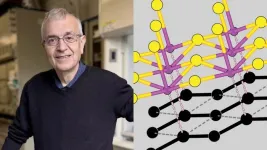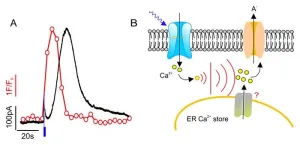(Press-News.org) A new PET scan reliably detects benign tumors in the pancreas, according to research led by Radboud university medical center. Current scans often fail to detect these insulinomas, even though they cause symptoms due to low blood sugar levels. Once the tumor is found, surgery is possible.
The pancreas contains cells that produce insulin, known as beta cells. Insulin is a hormone that helps the body absorb sugar from the blood and store it in places like muscle cells. This regulates blood sugar levels. In rare cases, the beta cells malfunction, resulting in a benign tumor called an insulinoma. This tumor almost never spreads, but it still causes problems due to excessive insulin production, leading to low blood sugar.
Alternative to pancreatic tissue slicing
‘People with this condition have little energy due to low blood sugar and often faint’, explains Marti Boss, first author of the study. ‘It's a very challenging disease. It often takes a long time before patients get a diagnosis. We can perform blood tests, but they can't confirm if a tumor is the cause or where it's located. Various scans like CT, MRI, and PET are available, but don’t always show the insulinomas.’
Removing the tumor surgically resolves the problem, but first, the tumor's location must be known. Martin Gotthardt, professor of Nuclear Medicine at Radboudumc, explains: ‘In the past, surgeons would start cutting away portions of the pancreas until they found the tumor. If it was at the end, the entire pancreas would be gone. You can live without a pancreas, but you'd struggle with severe diabetes and would constantly have to manage your blood sugar. So, a better scan was urgently needed.’
A new solution
Gotthardt and his team developed a completely new scan, the so-called Exendin-PET scan, which allows for the precise localization of insulinomas. They previously published results from a study in children, where the insulinoma is congenital. Now, they present findings from a study in adults, where the insulinoma developed gradually.
In the study, 69 adult patients with suspected insulinoma participated. The Exendin-PET scan detected tumors in 95% of the patients, compared to 65% with the current PET scan. When combined with CT and MRI, the current PET scan usually detected the tumor, but in 13% of cases, the insulinoma was only visible on the new scan. Boss adds: ‘We believe the new scan can replace all other scans. All the insulinomas we found with the new scan were removed, and all those patients were completely cured after surgery, even though some had been sick for decades.’
Lizard-derived technology
The new scan is based on a substance found in the saliva of the Gila monster, a type of lizard native to desert areas in the United States. Gotthardt explains: ‘We knew this substance specifically binds to a molecule on these tumors, the GLP1 receptor. The substance from the saliva wasn’t very stable in the human body, so we created a more chemically stable version, called Exendin. We then attached a radioactive substance to it, so it could be visible on a PET scan. Now, this mildly radioactive Exendin appears to perfectly detect insulinomas.’
The next step is to introduce the Exendin-PET scan into clinics as the standard scan for people suspected of having an insulinoma. Researchers will now assess how the scan improves patients' quality of life and how much money can be saved if other scans, like CT and MRI, are no longer needed. In addition, Gotthardt's team is investigating the potential use of Exendin for the treatment of insulinomas in a new research project called LightCure.
About the publication
The study was published in the Journal of Nuclear Medicine: Improved localization of insulinomas using 68Ga-NODAGA-exendin-4 PET/CT. M. Boss, O. Eriksson, K. Mikkola, A. Eek, M. Brom, M. Buitinga, A.H. Brouwers, I. Velikyan, B. Waser, S. Kauhanen, O. Solin, C. Marciniak, B. Eriksson, J. Reubi, C. Aveline, D. Wild, F. Pattou, J. Talbot, J. Hoflarsnd, A. Sundin, P. Nuutila, J. Hermans, M. Gotthardt. DOI: 10.2967/jnumed.124.268158.
END
Scan based on lizard saliva detects rare tumor
Benign tumors in the pancreas accurately visualized
2024-10-21
ELSE PRESS RELEASES FROM THIS DATE:
Rare fossils of extinct elephant document the earliest known instance of butchery in India
2024-10-21
During the late middle Pleistocene, between 300 and 400 thousand years ago, at least three ancient elephant relatives died near a river in the Kashmir Valley of South Asia. Not long after, they were covered in sediment and preserved along with 87 stone tools made by the ancestors of modern humans.
The remains of these elephants were first discovered in 2000 near the town of Pampore, but the identity of the fossils, cause of death and evidence of human intervention remained unknown until now.
A team ...
Argonne materials scientist Mercouri Kanatzidis wins award from American Chemical Society for Chemistry of Materials
2024-10-21
Mercouri Kanatzidis, a materials scientist at the U.S. Department of Energy’s Argonne National Laboratory and professor at Northwestern University, will receive the 2025 ACS Award in the Chemistry of Materials from the American Chemical Society, the nation’s leading professional organization of chemists.
The award “recognizes and encourages creative work in the chemistry of materials,” according to the citation.
At Argonne, Kanatzidis’s work has focused on the implications of a ...
Lehigh student awarded highly selective DOE grant to conduct research at DIII-D National Fusion Facility
2024-10-21
When it comes to sustainable energy, harnessing nuclear fusion is—for many—a holy grail of sorts. Unlike climate-warming fossil fuels, fusion offers a clean, nearly limitless source of energy by combining light atomic nuclei to form heavier ones, releasing vast amounts of energy in the process.
But it isn’t easy replicating and controlling the process that powers the sun.
“We eventually want to move to producing energy this way,” says Brian Leard ’21 ’25G, a ...
Plant guard cells can count environmental stimuli
2024-10-21
Plants control their water consumption via adjustable pores (stomata), which are formed from pairs of guard cells. They open their stomata when there is a sufficient water supply and enough light for carbon dioxide fixation through photosynthesis. In the dark and in the absence of water, however, they initiate the closing of the pores.
SLAC/SLAH-type anion channels in the guard cells are of central importance for the regulation of the stomata. This has been shown by the group of Professor Rainer Hedrich, biophysicist at Julius-Maximilians-Universität ...
UAMS researchers find ground beef packs bigger muscle-building punch than soy-based alternative
2024-10-21
When it comes to building muscle, not all proteins are created equal.
New research from the University of Arkansas for Medical Sciences (UAMS) reveals that 100% ground beef packs a bigger punch for muscle protein synthesis than a soy-based counterpart. In fact, the study suggests that a person would need double the amount of soy-based protein to achieve the same results.
Published in the American Journal of Clinical Nutrition, the study examined the anabolic response — how the body builds muscle — after consuming a 4-ounce beef patty versus one or two 4-ounce patties of a soy-based product. The results? Just one serving of beef did the ...
Study: AI could transform how hospitals produce quality reports
2024-10-21
A pilot study led by researchers at University of California San Diego School of Medicine found that advanced artificial intelligence (AI) could potentially lead to easier, faster and more efficient hospital quality reporting while retaining high accuracy, which could lead to enhanced health care delivery.
The study results, published in the October 21, 2024 online edition of the New England Journal of Medicine (NEJM) AI, found an AI system using large language models (LLMs) can accurately process hospital quality measures, ...
Four U-M faculty elected to National Academy of Medicine
2024-10-21
Four University of Michigan faculty have been elected to the National Academy of Medicine, one of the highest honors in medical research.
Kenneth M. Langa, M.D., Ph.D., Erica E. Marsh, M.D., MSCI, FACOG, Santa J. Ono, Ph.D. and Marc A. Zimmerman, Ph.D., are among 100 newly elected health and medical scientists recognized for their outstanding professional achievement and commitment to service.
They join the 79 other current, former and late U-M faculty who have earned this distinction. NAM members help the Congressionally chartered, private nonprofit organization provide objective advice to the nation on key health ...
FSU College of Medicine research team connects loneliness with heightened risk of dementia in largest study of its kind
2024-10-21
New research led by Florida State University College of Medicine faculty quantified the association between loneliness and dementia by analyzing data from more than 600,000 people around the world — the largest study of its kind.
The meta-analysis of 21 longitudinal studies showed that experiencing feelings of loneliness increased the risk of developing dementia by 31%. The research was published in Nature Mental Health.
“These results are not surprising, given the mounting evidence that link loneliness to poor health,” said Assistant Professor Martina Luchetti, who led the study. “Dementia ...
Berry studying nitrogen vacancy diamond metrology for temperature and pressure sensing
2024-10-21
Tyrus Berry, Assistant Professor, Mathematics, College of Science, received funding for the project: “Nitrogen Vacancy Diamond Metrology for Temperature and Pressure Sensing: Data Assimilation.”
Berry aims to provide the mathematical tools for a robust sensor that can simultaneously measure temperature, pressure, and force over a long range of values in harsh environments.
The sensor readings will be tied to fundamental physics laws, and the mathematical framework will automatically track any drift in the ...
Antil studying structure preserving optimization algorithms and digital twins
2024-10-21
Antil Studying Structure Preserving Optimization Algorithms & Digital Twins
Harbir Antil, Professor, Mathematical Sciences, College of Science, received funding from the National Science Foundation to study partial differential equation (PDE)-constrained optimization problems that incorporate data to make decisions in the presence of uncertainty arising from modeling unknown quantities.
The proposed methods support various application areas, including digital twins where physics and data are fused to support decision making.
One graduate student will be supported by the project and the ...
LAST 30 PRESS RELEASES:
New software sheds light on cancer’s hidden genetic networks
UT Health San Antonio awarded $3 million in CPRIT grants to bolster cancer research and prevention efforts in South Texas
Third symposium spotlights global challenge of new contaminants in China’s fight against pollution
From straw to soil harmony: International team reveals how biochar supercharges carbon-smart farming
Myeloma: How AI is redrawing the map of cancer care
Manhattan E. Charurat, Ph.D., MHS invested as the Homer and Martha Gudelsky Distinguished Professor in Medicine at the University of Maryland School of Medicine
Insilico Medicine’s Pharma.AI Q4 Winter Launch Recap: Revolutionizing drug discovery with cutting-edge AI innovations, accelerating the path to pharmaceutical superintelligence
Nanoplastics have diet-dependent impacts on digestive system health
Brain neuron death occurs throughout life and increases with age, a natural human protein drug may halt neuron death in Alzheimer’s disease
SPIE and CLP announce the recipients of the 2025 Advanced Photonics Young Innovator Award
Lessons from the Caldor Fire’s Christmas Valley ‘Miracle’
Ant societies rose by trading individual protection for collective power
Research reveals how ancient viral DNA shapes early embryonic development
A molecular gatekeeper that controls protein synthesis
New ‘cloaking device’ concept to shield sensitive tech from magnetic fields
Researchers show impact of mountain building and climate change on alpine biodiversity
Study models the transition from Neanderthals to modern humans in Europe
University of Phoenix College of Doctoral Studies releases white paper on AI-driven skilling to reduce burnout and restore worker autonomy
AIs fail at the game of visual “telephone”
The levers for a sustainable food system
Potential changes in US homelessness by ending federal support for housing first programs
Vulnerability of large language models to prompt injection when providing medical advice
Researchers develop new system for high-energy-density, long-life, multi-electron transfer bromine-based flow batteries
Ending federal support for housing first programs could increase U.S. homelessness by 5% in one year, new JAMA study finds
New research uncovers molecular ‘safety switch’ shielding cancers from immune attack
Bacteria resisting viral infection can still sink carbon to ocean floor
Younger biological age may increase depression risk in older women during COVID-19
Bharat Innovates 2026 National Basecamp Showcases India’s Most Promising Deep-Tech Ventures
Here’s what determines whether your income level rises or falls
SCIE indexation achievement: Celebrate with Space: Science & Technology
[Press-News.org] Scan based on lizard saliva detects rare tumorBenign tumors in the pancreas accurately visualized





